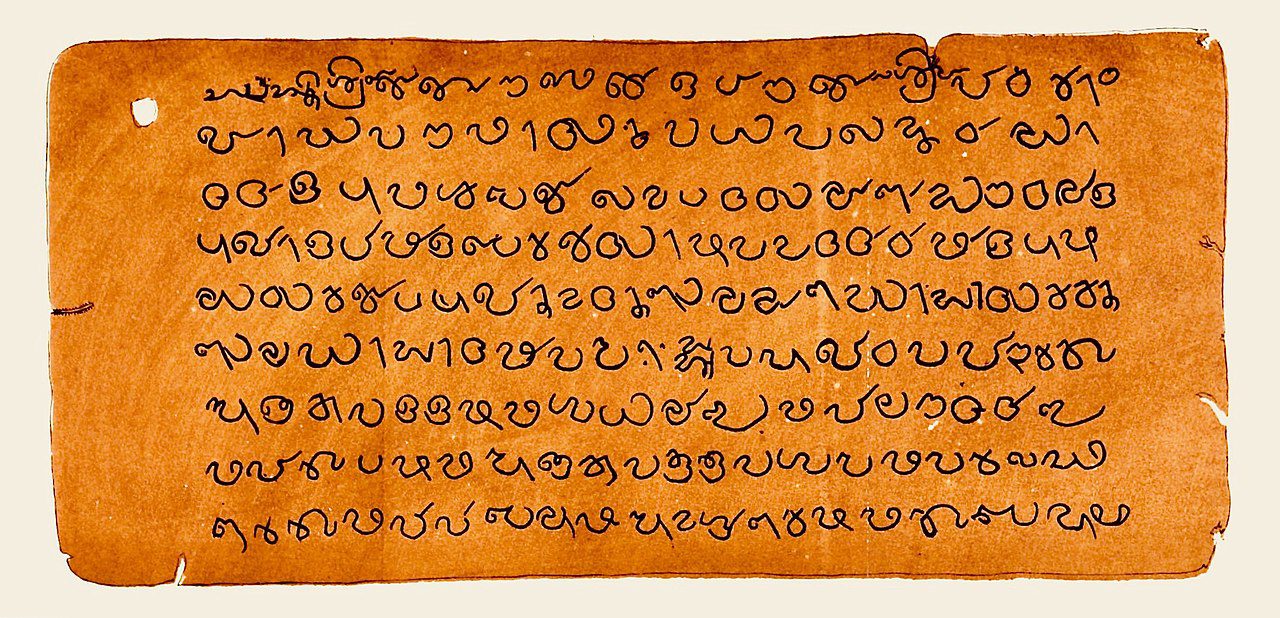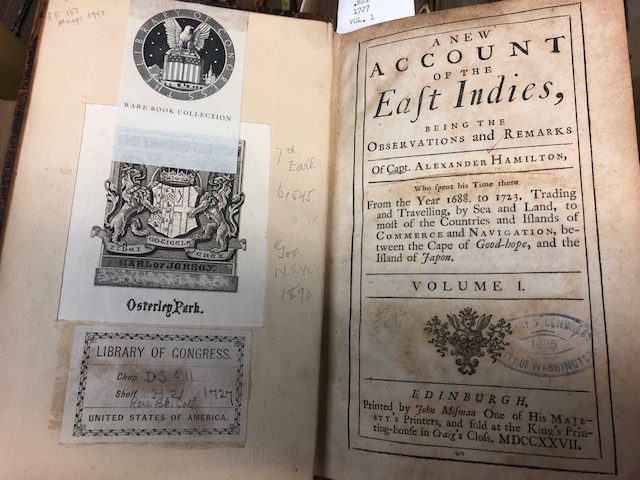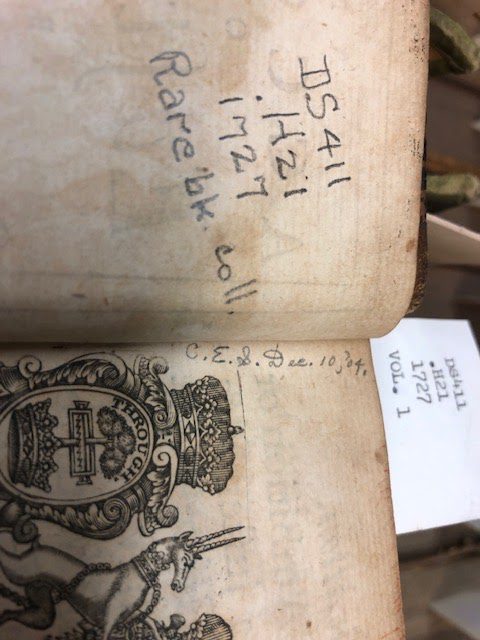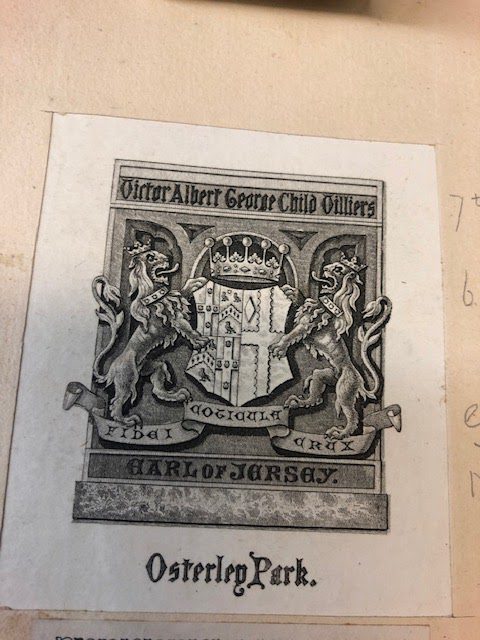A recent post here critiqued an attempt to explain the origins of the book of Ether based on inspiration from a rare book, A Key to the Chronology of the Hindus from a man named Alexander Hamilton (not the US statesmen). After substantial revision, my post was just published on the Interpreter Foundation’s blog as “Was a Rare Book on the Hindu Religion a Source for the Book of Ether?” To my surprise, a comment was posted there suggesting a more relevant book from Alexander Hamilton. It turns out this was yet another Alexander Hamilton, a Captain Alexander Hamilton who had experience in the “East Indies,” including India. He published his story in another large book almost a century before his namesake’s book on the Hindus came out. It’s actually relevant to the Book of Mormon in a couple of ways.
Here is the comment made by someone posting as “RM”:
Both Lindsay and Toponce swing and miss. I recommend reading the earlier texts of Alexander Hamilton, particularly those describing members of the House of Manasseh and their brass/copper plates containing “their own history from the reign of Nebuchadnezzar to this present time”. – A New Account of the East Indies
As in there were historical Israelites from the Tribe of Manasseh in this region of the world, and the accounts given by Hamilton were an accurate telling of their history.
Now that sounds much more interesting than what one can find in the later Hamilton’s book, which is frankly a very poor candidate as a source for the Book of Mormon. Captain Alexander Hamilton first published his book in 1723, with some later editions. The 1744 edition is available at Google Books: https://www.google.com/books/edition/A_New_Account_of_the_East_Indies/-jNagGDT-PsC?hl=en&gbpv=1. Was A New Account of the East Indies available in the US for Joseph Smith the bookworm to access? Or could it at least have influenced his technical advisory team or Joseph’s broad circles of literati?
Unlike the later Hamilton’s book, which wasn’t widely distributed even in England where it was published, this earlier book had made it to the shores of the US by 1830 since the 1830 catalog of the library at Harvard shows it listed. However, it still may have been rather rare, for the Library of Congress, building upon Thomas Jefferson’s vast library, did not obtain the book until 1904, based on my query with the extremely helpful Rare Books Collection team (email received Dec. 15, 2020). It wasn’t in the noteworthy Rochester City Library in 1839. The 1821 catalog at the very large library of Allegheny College also fails to show this book. But at least we know that Harvard had it, so it’s possible that Joseph’s better educated farmer friends knew all about it, though given that its topic that would seem to have no value for Joseph or his peers and given the few words of material that intersects with Book of Mormon issues, it’s unlikely this had any impact on Joseph and his environment. But if Joseph did read it, what would he have gleaned?
In discussing travels to India and beyond, the book raises the issue of the diaspora of the Jews on pages 323–325 (1744 edition), and mentions that some Jews in India said to be descended from the Jews who were carried away to Babylon during the Exile had a tradition about preserving their history on metal plates. Jews writing their history on metal plates? I’ve heard that somewhere before….
There is now a good body of evidence showing that other Jews and Semitic peoples had put various writings on metal (see https://scholarsarchive.byu.edu/cgi/viewcontent.cgi?article=1695&context=msr), but it was a source of mockery in Joseph’s day. For that Jewish colony in India, I don’t know what became of their recorded history on metal plates, if they really had one — there may be a sacred treasure waiting to be revealed sometime soon, for all I know — but the Jews of the colony appear to have had at least one important document on metal plates, an engraving of a royal charter for their colony from the king of Kerala about 1000 years ago and at least a replica of the plates still exists. See “Jewish Copper Plates of Cochin,” Wikipedia, https://en.wikipedia.org/wiki/Jewish_copper_plates_of_Cochin. More on that issue in a moment.
Here is the relevant passage in Captain Alexander Hamilton’s book on p. 324:
They [the Jews in Cochin, India] have a Synagogue at Cochin, not far from the King’s Palace, about two Miles from the City, in which are carefully kept their Records, engraven in Copper-plates in Hebrew characters; and when any of the Characters decay, they are new cut, so that they can shew their own History, from the Reign of Nebuchadnezzar to the present Time….
They declare themselves to be of the Tribe of Manasseh….
While we don’t know the details, this at least suggests that in a colony founded by ancient Jews there was an old tradition about preserving important documents on metal. Interesting. Also interesting is the connection to the tribe of Manasseh, part of the tribe of Joseph, giving another connection to the Book of Mormon.
RM also offered a link to a source in India raising questions about the authenticity of the royal charter on copper plates. See “Few Translations of the Jewish Copper Plates and the Doubtful Authenticity of the Plates,” Geopolitical Strategic and Security Studies Institute (GSSSI), India (no date). This reviews the history of the plates with the purported royal charter on them, discusses attempted translations, and raises questions about their authenticity. The focus is on Claudius Buchanan, who visited Cochin decades after Alexander Hamilton and allegedly purchased the plates with the royal charter and had a replica made. The replica had engravings on one side of two plates, while the original allegedly had both sides of a plate engraved. Here is an ancient drawing made of one part of the plates:
 |
| Jewish copper plates of Cochin (plate I, side I), a photo of 2-D artwork created before the 11th-century CE. Royal charter issued by the Chera/Perumal king of Kerala, south India to Joseph Rabban, a Jewish merchant magnate of Kodungallur. The charter shows the status and importance of the Jewish colony in Kodungallur (Cranganore) near Cochin, India. There were 28 lines on three sides of two copper plates dating to the early 11th century AD. Script: Vatteluttu (with Grantha/Southern Pallava Grantha script) Language, an early form of Malayalam. Courtesy of Wikimedia Commons, Wikipedia, “Jewish Copper Plates of Cochin.” |
What happened to the plates? Were there ever real plates? Is it all just some kind of joke or fraud? GSSSI has many doubts, but, as shown in the paragraph below, they strike me as having a rather strong bias when they interpret the University of Cambridge’s answer to their query as evidence of the “non-existence or loss of the original brass plates” when it seems that the reply simply means the University hasn’t done any research on the plates yet. Plates that have a manuscript number in a university catalog is not the normal way of treating items that simply don’t exist:
Buchanan writes in his Annual Report that the plates were originally in brass of which he made copper facsimiles. The original was engraved on both sides while the facsimiles were on two separate plates. He mentions that these plates were deposited in the Public Library at the University of Cambridge. But Thoufeek Zakriya, a researcher, mentions that in response to his inquiry to the Cambridge University, Ms. Catherine Ansorge, Head of Near Eastern Department, (manuscripts and printed Collections, Cambridge University Library) replied by a personal mail about the MsOo.1.14, Charter of Jews of Cochin, which was submitted by Dr. Claudius Buchanan stating “Oo.1.14 — the texts are all written on rectangles of copper. I do not know of any studies which have been carried out on these” thus confirming the non-existence or loss of the original brass plates even in the Cambridge University or it is that the original brass plate was never deposited by Claudius Buchanan but instead what he deposited was a copper facsimile. Buchanan also writes that the plates were taken to London. Does the brass plate still exist in London and if so in whose possession and why it has to be kept secret even from Indian historians is a ‘mystery’ yet to be solved.
Meanwhile, multiple studies have been published on the plates and scholars seem convinced that these are real, ancient, and non-fraudulent. See the Wikipedia article cited above and its sources, as well as the following:
1. Barbara C. Johnson, “New Research, Discoveries and Paradigms: A Report on the Current Study of Kerala Jews” in Indo-Judaic Studies in the Twenty-First Century, ed. Nathan Katz et al. (New York: Palgrave MacMillan, 2007), 129-146, online at https://link.springer.com/chapter/10.1057%2F9780230603622_8. Here is an excerpt from pp. 129-130:
Fresh historical insight into the early Jewish community in Keralahas emerged from new publications by the esteemed Kerala historian M. G. S. Narayanan, professor and head of the Department of History Emeritus at Calicut University. More than thirty years had passed since the publication of his definitive analysis of the eleventh century Jewish copper plates, still a basic source for all scholarship in the field, when his very welcome renewal of interest in the Kerala Jews was marked by participation in two scholarly gatherings, in Oxford in 2002 and in Israel in 2005. In a 2003 article, he once again turned his scholarly attention to the copper plates, enriching his earlier analysis of their sociopolitical context, and in 2005 he analyzed the leadership position of copper plate recipient Joseph Rabban in the context of eleventh century Kerala society and politics. Both these papers drew extensively from and expanded on material and analysis in his recently published monumental study on Kerala in the ninth to twelfth centuries, Perumals of Kerala. It is hoped that this volume will soon be published for wider circulation.
In addition to the important work in this volume by Chakravarti and Weinstein on ancient and medieval contacts between India and Jews in other lands, mention should be made of a 1992 article by the Israeli scholar MeirBar Ilan, exploring contacts between the Jewish communities of Yemen andSouth India. This study is based on interpretation of the controversial eigh-teenth century Cochin Jewish chronicle “Maggid Hadashot,” which is unusual in locating the origin of the Kerala Jews in Yemen. Bar Ilan relates part of its contents to similar eighteenth century Hebrew compositions from Yemen about the history of the Yemenite Jews. He then investigates the possibility that at least some of the manuscripts which are mentioned in the chronicle were actually copies of ancient “lost” apocryphal books, preserved in Yemen and brought to Kerala at a much earlier time.Whatever questions there might be about his analysis of the origin of the chronicle and of the “lost books” mentioned in it, Bar Ilan’s article is valuable in its identification of sources on early contacts between Yemen and Kerala. This topic is of particular interest to scholars exploring Yemenite liturgical and musical influences in Kerala, and to those examining Malabari alternatives to the “Joseph Rabban/Cheraman Perumal/Kodungallur” legends, as found in several other Cochin chronicles and at least one Malayalam folksong.
2. M. G. S. Narayanan, “Further Studies in the Jewish Copper Plates of Cochin,” Indian Historical Review, 29/1–2 (Jan. 2002):19-28, online at http://www.mei.org.in/uploads/jijscontent/59-1534436177-jijsarticlepdf.pdf.
Narayanan explains that the language on the plates is consistent with other engravings in that part of India anciently and follows unusual ancient patterns in which dates were sometimes split up, perhaps out of superstition. Such elements are subtle indications of authenticity and antiquity.
It’s interesting that engravings on both stone and copper in that part of India were part of the local elite culture anciently. Did the Jewish tradition of engraving on metal influence their environment, or did the Jewish interest in metal engravings derive from their environment, or were both independent? I’m not sure and would appreciate your input if you’re familiar with this issue.
In any case, while the 1821 book of Alexander Hamilton on the Hindus is not of much interest for understanding Book of Mormon, a Captain Alexander Hamilton almost a century earlier had one brief section in his large book that hints at what we know from other sources: some ancient Jews may have had a tradition of recording scripture and their own history on metal plates. In spite of his brief hint on this topic, the idea of ancient Hebrews writing on metal plates was widely mocked in Joseph’s day and was not part of common knowledge in Joseph’s environment.
Also of interest is the connection of the Cochin Jews to the ancient Jews in Yemen, some of whom Lehi and his family may have encountered, especially when they came to the place that others, perhaps local Yemeni Jews, called Nahom, likely in the region of the tribal lands for the ancient Nihm tribe of Yemen. That region is about 25 miles north of Sana’a and in just about the only place where one can leave the general scope of the Incense Trail and turn nearly due east with a chance of surviving and not only reaching the coast of Oman, but reaching the miraculous but real place called Bountiful.
For Lehi’s family, meeting a group of Jews at Nahom would have been a miraculous blessing that would have made it possible to give a proper Jewish burial to Ishmael, whose burial at Nahom is recorded in 1 Nephi in the Book of Mormon. Note that Captain Hamilton is not aware of the Yemen connection and writes that the Jews of Cochin fled from Babylon after the Exile. But if they were from the Northern Kingdom, as suggested by their tribal affiliation, they might have been part of the many Hebrews who fled the Assyrian invasion by going to Yemen. Perhaps some later sailed from there for India?
There’s much to explore here. I’m grateful for the kind leads provided by RM and welcome any further information you may have.
Here are some images the Library of Congress kindly sent me of two of their copies of Captain Hamilton’s books in their Rare Books Collection, both showing acquisition long after Joseph Smith’s day. Beautiful books! And they come with a tiny treasure that intersects lightly with our Book of Mormon and hints at further treasures to uncover.













What strikes me most upon reading this post is the way that genuine communities of the ancient Jewish diaspora, such as those of the Kochin Jews in India, leave behind abundant evidence of their ancientness, whereas their purely imaginary counterparts, such as the Nephites of the New World, do not.
— OK
"but it was a source of mockery in Joseph’s day"
You keep saying that, but never back it up.
Thanks! Awesome, as always.
And Anon, you know there's abundant evidence for the BofM, and thus…for Nephites : ).
This account appears to support Ryan Thomas's thorough analysis of ancient writing on metal plates. All of it discovered so far is limited to short documents. There is no example of a lengthy history engraved on metal places. Period.
Thanks anon 11:28. That fact has been pointed out endlessly to Jeff. The minute a child learns to write, the parents have to stop the child from writing on everything, walls, furniture, etc.
Always amusing when you compare actual existing artifacts — often thousands of years old — to the enormous trove of non-existent Mormon "artifacts" which would supposedly be just a few hundred years old in an age of various technologies available to locate them.
Also no other examples of writing on metal plates that were hidden away and safeguarded by an angel who turns out to be unfamiliar with his own geography and cultural heritage, who shows the plates to a young boy but doesn’t allow him to touch them (look, but don’t touch!) for four years, who finally turns them over to the now young man to be translated without the young man ever reading them or referring to their text in the translation process, which angel then takes back the plates to who-knows-where, but allows about 11 people to see and touch the metal plates (but some only in spirit) before disappearing them from the face of the earth for good. Oh, and don’t forget that the angel had the foresight before he died to write an 18th-19th century-style cover page that he sandwiched between the last plate in the translated section and a sealed portion of the plates which had the appearance of solid wood and were 2/3 bigger than the translated portion.
The whole origin story of the BoM is pretty unprecedented and incredible (some would say un-credible).
anon @12:48 well when you put it that way it sounds ridiculous! (which it is)
Jeff, show us where people mocked Joseph for this or retire this nonsense forever. Apologetics don't convert, if that's even what you're after anymore. They don't make you look smart, either. They discredit you. We can only gaze in wonder that you believe this nonsense. Not even the church itself jumps through these hoops anymore.
Anon@10:44 writes, "You keep saying that, but never back it up." This anonymous comment complains that I have never backed up the allegation that Joseph was mocked for the claim that some people in antiquity kept a record on metal plates. A brief search here or on my website would reveal I have already provided such documentation. See the last half of "Those Implausible Golden Plates of the Book of Mormon: Why I Gave in to Anti-Mormon Pressure" on my website. On the sidebar of this blog, you should see a link to the Mormanity post, "Those Implausible Plates," with similar information.
Notice that a large portion of the critical replies to this very post attack the idea of Hebrews keeping a record on metal plates. It's still laughable to many. Metal plates, of course, would be extremely rare and precious, not a common household item. Less common than diamonds. But now that we know of multiple traditions among ancient Jews about writing scripture and important records on metal, the fact that we haven't found long records does not mean they did not exist.
Arguing that Joseph's plates are implausible because there are no known instances of anybody keeping a lengthy record on metal plates seems to reflect a failure to try to read this post, which provides evidence that the Jews of Cochin, India at least claimed to have kept a record of their history on metal plates.
Another comment mocked the idea of sacred plates that are no longer present and another mocked the alleged absence of Book of Mormon artifacts, when this post points out that the original 1000-year-old copper plates from an Indian king related to the Jews of Cochin appears to be absent or its location is unknown, as is the case also for the engraved history that they claimed to have kept over the centuries.
Uncertainties about the precise location of ancient Book of Mormon cities in the New World coupled with the relative infancy of archaeology in the New World relative to the ancient Near East makes it far too early to make any meaningful arguments based on the uncertainty of Book of Mormon relics in the New World, apart from the abundance of evidence for the plausibility of the many details in the Book of Mormon such as cities made of cement, roads leading to central market places, the type of fortifications described in the text, the destruction of major cities by apparent volcanism and seismic events, etc. But when we turn to the Old World, where we can pin down specific locations more easily, we find abundant evidence in favor of the Book of Mormon, including altars in Yemen bearing the NHM name and being near the tribal lands of the NHM tribe and dating to slightly before Lehi's day, as well as incredibly plausible candidates for the once-mocked River Laman and Bountiful, as well as Shazer and Nahom.
"A brief search here or on my website would reveal I have already provided such documentation."
The documentation has already been debunk on this blog, something you have already admitted in other threads.
As you know this:
"that Joseph was mocked for the claim that some people in antiquity kept a record on metal plates."
and this:
"Notice that a large portion of the critical replies to this very post attack the idea of Hebrews keeping a record on metal plates."
are two different things and just further goes to your dishonesty.
The moment child learns to write, they write on everything. The idea has never been considered laughable or mocked. As you know, that is a deceitful fiction you invented.
"makes it far too early to make any meaningful arguments"
200 years of trying and it is still to early, in other words, no amount of evidence will change an persons mind. With that mentality anything you want to be true is true.
"we find abundant evidence in favor of the Book of Mormon, including altars in Yemen bearing the NHM name and being near the tribal lands of the NHM tribe and dating to slightly before Lehi's day, as well as incredibly plausible candidates for the once-mocked River Laman and Bountiful, as well as Shazer and Nahom."
Now that is a perverted definition of abundant. With that definition, anything one wants to be true is true.
I recently discovered a metal plate amongst my grandmothers items she left behind. There is Arabic and Hebrew written on the front with a lion in the middle and on the back appears to be a family tree. I recognise some of the names from my own family history research. Anyone know where I can get this verified? Thanks !